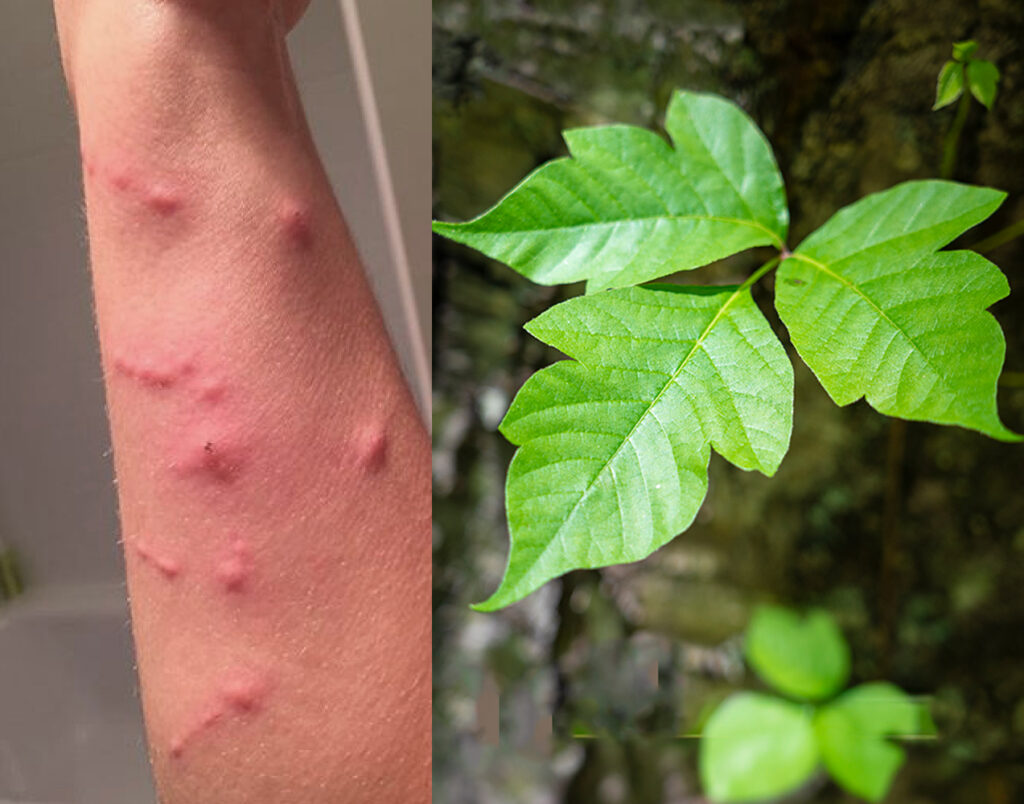From Skin to Eyes: Poison Ivy Rash Symptoms to Recognize

Encountering poison ivy during your outdoor adventures can turn a delightful day into an uncomfortable ordeal. Recognizing the early symptoms of a poison ivy rash and knowing how to respond effectively is crucial. From skin reactions to severe cases involving the eyes, inhalation, or ingestion, understanding these symptoms can help you take swift action. We will guide you through identifying and treating poison ivy exposures.
What is Poison Ivy?
Poison ivy is a plant that contains an oily resin called urushiol, which causes an allergic reaction in most people who come into contact with it. This reaction often results in a red, itchy rash that can develop into blisters. Poison ivy grows as a shrub or vine and is commonly found in wooded areas, fields, and along roadsides throughout North America.
Identifying Poison Ivy Rash
A poison ivy rash is characterized by redness, itching, and swelling at the contact site. It often appears in streaks or lines, reflecting how the plant brushed against the skin. As the rash progresses, small bumps or blisters may form, which can ooze and crust over. The severity of the rash can vary depending on the amount of urushiol exposure and an individual's sensitivity.
Early Poison Ivy Rash Symptoms
Recognizing the early symptoms of a poison ivy rash can help you take action before it becomes more severe. Early warning signs include:
- Itching: One of the first signs of a developing rash is an itchy feeling in the area where the skin was exposed to urushiol.
- Redness: The skin may start to turn red before the rash fully develops.
- Swelling: Mild swelling can occur at the site of contact.
- Rash Formation: Small red bumps may appear before they turn into full-blown blisters.
If you notice any of these early symptoms, it’s crucial to cleanse the area with a product like Tecnu Cleanse to remove any remaining urushiol and prevent the rash from worsening.
What to Do If You Get Poison Ivy in Your Eye
Symptoms of Poison Ivy in Eye
Getting poison ivy in your eye is a serious situation that requires immediate attention. Symptoms may include:
- Redness and Swelling: The eyelid and surrounding area may become red and swollen.
- Intense Itching or Burning: Affected individuals may experience severe itching or a burning sensation.
- Watery Eyes: The eyes may produce more tears than usual.
- Blurry Vision: Vision may become temporarily blurred due to irritation.
Treatment Steps
- Rinse Immediately: Rinse your eye with clean, lukewarm water for at least 15 minutes. Use an eye wash station if available, or gently pour water over your open eye.
- Avoid Rubbing: Do not rub your eye, as this can spread the urushiol and worsen the irritation.
- Seek Medical Attention: Contact a healthcare professional immediately for further advice and potential treatment.
What to Do If You Inhale Poison Ivy
Symptoms of Poison Ivy Inhalation
Inhaling urushiol, typically from burning poison ivy plants, can lead to severe respiratory symptoms. These may include:
- Coughing and Wheezing: Inhaling urushiol can irritate the respiratory tract, leading to coughing and wheezing.
- Shortness of Breath: Breathing difficulties may occur, and in severe cases, this can be life-threatening.
- Sore Throat: The throat may become sore and scratchy.
- Nasal Congestion: The nasal passages may become inflamed and congested.
Treatment Steps
- Move to Fresh Air: Immediately move away from the area where the plant is burning.
- Seek Emergency Help: Inhaling urushiol can cause severe reactions. Contact emergency services or go to the nearest emergency room.
- Follow Medical Advice: Follow the treatment plan provided by healthcare professionals, which may include medications to reduce inflammation and ease breathing.
What to Do If You Eat Poison Ivy
Symptoms of Poison Ivy Ingestion
Ingesting poison ivy is rare but can cause serious symptoms, including:
- Mouth and Throat Irritation: The mouth and throat may become irritated and swollen.
- Stomach Pain: Ingesting urushiol can cause stomach cramps and pain.
- Nausea and Vomiting: The body may react by attempting to expel the toxin through vomiting.
- Difficulty Swallowing: Swelling and irritation can make swallowing difficult.
Treatment Steps
- Do Not Induce Vomiting: Do not attempt to induce vomiting unless instructed by a medical professional.
- Drink Water: Drink plenty of water to help dilute the urushiol and flush it from your system.
- Seek Immediate Medical Help: Contact poison control or go to the emergency room immediately for professional treatment.
How to Treat Poison Ivy Rash
Treating a poison ivy rash promptly can alleviate symptoms and prevent complications. The Ivy Complete Kit provides a comprehensive solution for treating poison ivy and poison oak rashes.
A Complete Solution: Ivy Complete Kit
Step 1: Cleanse To Remove the Rash-causing Oil
Use Tecnu Cleanse to remove the rash-causing oils from your skin. This step is crucial for stopping the rash before it starts or preventing it from spreading if it has already begun. Scrub with Cleanse as soon as you notice any signs of a rash.
Step 2: Stop Your Misery with Maximum Strength Itch Relief
Apply Tecnu Treat, a maximum-strength anti-itch gel to alleviate redness, irritation, and pain. Its clear formula soothes and calms the skin without the mess of traditional calamine lotion. Tecnu Treat is also effective for bug bites and sunburns.
Step 3: Prevent Future Rashes
Use the convenient Tecnu Detox Wipes, individually wrapped wipes to remove urushiol oil as soon as the plant touches you. These wipes are perfect for on-the-go use and are also safe for removing the oil on pets and garden tools.
Using the Ivy Complete Kit ensures you have everything you need to tackle poison ivy exposure and manage symptoms effectively.
Recognizing the early symptoms of poison ivy rash and knowing how to treat severe exposures to urushiol can prevent significant discomfort and health risks. The Ivy Complete Kit offers a comprehensive and effective solution to keep you prepared for any encounters with poison ivy, oak, or sumac.




